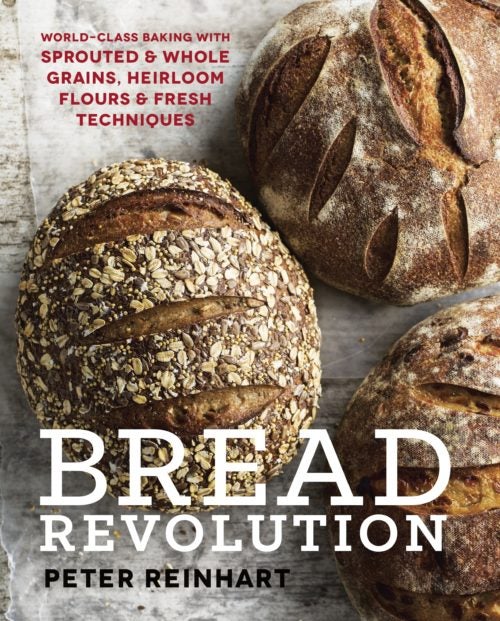








Peter Reinhart explores the rich world of bread baking in Bread Revolution.
This wet, rustic dough is a small-scale version of the one Craig Ponsford uses at Ponsford’s Place for both his ciabatta and his Wednesday night pizza events. I also use it for focaccia. It requires a poolish pre-ferment for structure, acidity, and maximum flavor development. The dough also contains a bit of coarse whole rye flour, also known as pumpernickel flour; it adds texture and contributes to the flavor complexity. Between the poolish and the water in the final dough, the total hydration of this dough is very close to 100% water to flour, and that’s one of the secrets to making whole wheat products at the quality level to which Craig aspires. It takes practice to learn to handle such wet dough, whether using oiled hands as I do or floured hands as many bakers, including Craig, prefer. You may be tempted to add more flour when mixing it to make the dough feel more “normal.” Try to resist that urge, as whole-milled flour will eventually absorb a lot of water. And with the help of the three stretch and fold sequences, the dough will firm up enough to handle. Still, it may seem wetter than you’re used to. This is where handling technique can make or break the final result. Especially when this dough for ciabatta is used, it must be gently cradled.
Directions
- In a small bowl, stir together the flour, yeast, and salt. Add the water and stir until the flour is hydrated and a thick, batter-like dough forms, about 1 minute. Use a wet bowl scraper to scrape down the sides of the bowl. Cover the bowl with plastic wrap and let the poolish rest at room temperature for 12 hours or overnight, until it gets very bubbly and swells in size. If it gets very bubbly before you’re ready to make the final dough, put it in the refrigerator. If you do so, use lukewarm water, at about 95°F, when mixing the final dough.
- In the bowl of a stand mixer fitted with the paddle attachment, or in a large bowl, stir together the water and poolish (on low speed if using a stand mixer). Add the flours, salt, and yeast and mix or stir for 1 minute. Scrape down the bowl with a spatula or bowl scraper, then mix or stir for 3 minutes. If using a stand mixer, increase the speed to medium-low, and if mixing by hand, use a large spoon or your hands, dipped in water from time to time to minimize sticking, and mix for 3 minutes longer. The dough should be soft, wet, and very sticky.
- Mist a bowl with vegetable spray oil or lightly coat it with vegetable oil. Using a wet or oiled bowl scraper, transfer the dough into the bowl. Working either in the bowl or on a lightly oiled work surface, stretch and fold the dough, folding it over itself four times: once each from the top, bottom, and sides. Return the dough to the bowl, smooth side up, and cover the bowl (or again leave the dough on the work surface and cover with the bowl). Then, at intervals of 1 hour, perform two additional sequences of stretching and folding. For each stretch and fold sequence, lightly oil your hands to prevent sticking. After the final stretch and fold, cover the dough and let it rest at room temperature for 15 to 20 minutes (or up to 1 hour for more fermentation if the dough seems sluggish). The dough will become firmer with each stretch and fold. After the third stretch and fold, it will be a bit bouncy when patted but will still be soft and sticky.
- Use the whole piece of dough for a large ciabatta, or divide it in half for 2 smaller ciabattas. Dust a sheet pan with about 3 tablespoons of whole wheat flour or a blend of whole wheat and rye flour. With floured hands, lift, cradle, and transfer the dough pieces to the pan and gently fold each piece in thirds, like a letter,using the flour on the pan to coat the outer surface as you fold. (Alternatively, leave the pieces unfolded, coat with flour, and place them on the pan; this yields what the French would call pain rustique, eliminating the need to flip them over during proofing, as for ciabatta.) Roll the shaped dough in the flour to coat it again, then lay the dough seam side down on the floured pan, gently forming each piece into a slipperlike oblong or rectangle. Proof, uncovered, at room temperature for 30 minutes. Gently flip so the seam side is up, then proof for 15 to 25 minutes longer.
- About 45 minutes before you plan to bake, prepare the oven for hearth baking with a baking stone and steam pan. Preheat the oven to 550°F or as high as it will go.
- Just before baking, dust a peel with flour, or cover it with parchment paper and mist with vegetable spray oil. Gently transfer the shaped dough to the peel, cradling it in your hands for support and laying it seam side up. Coax the dough back into a slipper shape with floured hands. Slide the dough (and the parchment if using) onto the baking stone and pour about 1 cup of hot water into the steam pan. Lower the temperature to 400°F. Bake for 20 minutes, then rotate (if using parchment, slip it out from under the dough and discard). Bake for about 10 to 15 minutes longer for 2 small loaves or 20 to 30 minutes longer for a large loaf, until the bread sounds hollow when thumped on the bottom. The internal temperature should be at least 200°F.
- Transfer to a wire rack and let cool for at least 30 minutes before slicing or serving.
Reprinted with permission from Bread Revolution © 2014 by Peter Reinhart. Published by Ten Speed Press, an imprint of Penguin Random House, LLC.

